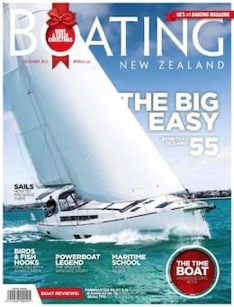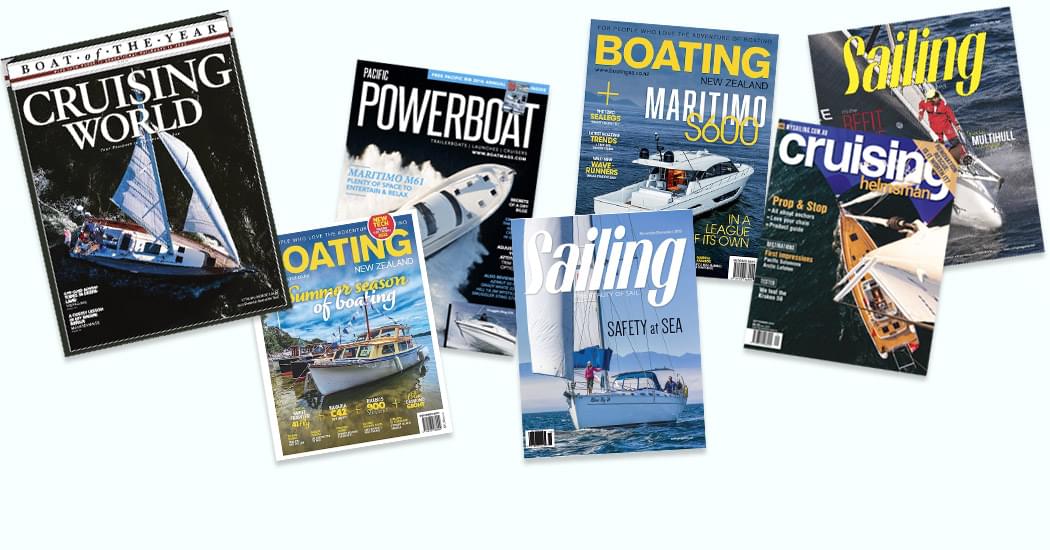
Dibley's Beau 770, Machine Speed
11 23 Topic : Yacht Reviews

'Machine SPEED'
Super-slick, go-fast racing yachts aren’t always synonymous with wallet-busting costs, as is proved by the new Beau 770 streaking around Auckland’s Waitemata harbour.
Boating NZ1 Dec 2015. Words by Ben Gladwell Photos by Bryce Taylor
On the way to Westhaven Marina to meet Mark Beauchamp and his home-built Beau 770, I saw kiteboarders blasting alongside the northwestern motorway.

The Royal New Zealand Yacht Squadron’s website suggested winds averaging 25 knots, gusting 30. This was confirmed by the Coastguard app – winds averaging 27 knots, gusting 31 at Bean Rock.
At that point, I’d only seen a photo of the Beau 770 but the early signs were good – wide transom, hard chines, twin rudders, square-top main and lots of volume in the bow.
This is going to be fun, I thought. I was right. The Beau 770 turned out to be one of the most enjoyable yachts I’ve reviewed for Boating NZ.
GENESIS
Mark Beauchamp began sailing at age eight on a yacht built by his father. When designing the Beau 770 he wanted to recreate one of the elements he believes is missing from today’s yachting scene – young men and women self-building boats with one goal in mind: going as fast as possible without spending a fortune.
“I wanted to come up with a design that a family or a group of young guys going in as a syndicate could buy and build themselves,” he says. “When I was young that’s what we did. We built our own go-fast boats because it was cheap.”
He’s certainly got the fast part sorted. When Mark took Boating NZ for a sail we clocked up 18.6 knots inside the harbour under main and jib alone. And he isn’t too far off on the price bit either. Depending on how advanced you go with the sail wardrobe, says Mark, you can buy and build a Beau 770 for around $30,000.
“I discussed the concept with well-known yacht designer Kevin Dibley and Phil Houghton of UK Sailmakers,” says Mark. “We agreed on a flat plywood pack with the intention of selling precut flat-pack frames and a jig.
“The prototype is double diagonal 4mm ply on the bottom with 6mm topsides laid over yellow cedar stringers. Deck is 6mm and the cabin is 12mm strip plank cedar with 450-gram double bias E-glass cloth both sides. The entire hull is skinned with double glass cloth, as is the inside throughout the impact areas and around the centre case.
“I received a lot of support for my idea from Kevin, who fine-tuned my rough drawings and checked my calculations. He is happy to work in conjunction with other designers.”
of these factors gives her a very powerful hull shape and is the key to her speed.
Another hat tip to open ocean-racing yachts is the twin rudders. Dual rudders can be highly effective on yachts with wide hulls and hard chines, as a single rudder would often lift a lot of the blade from the water when heeling, requiring a large blade for a satisfactory grip on the water.
Having a rudder on each side, angled outward when the boat is at rest means they stand vertically in the water as the yacht heels. This provides excellent grip on the water and requires much smaller rudder blades with less hydrodynamic drag.
“We spent a lot of time getting the toe-angle right,” says Mark. “You don’t want the rudders both pointing directly forward when the tiller is in the centre. They should be pointing out slightly.”
So when one of the rudders is turned and working to keep the yacht straight, the other will be pointing straight ahead, not dragging sideways through the water.
By modifying the IMOCA 60 style tie-rods, which join the rudders together so they work in unison when the tiller moves, Mark has come up with a simple system for adjusting the rudders’ toe-angle. Using a set of bottle screws, the tie rods can be shortened and lengthened easily to tune the amount of toe angle. Serious racing teams will adjust the amount of toe angle for a given point of sail and speed.
The rudder blades slot into a cassette rather than being fixed to the boat, so they can be easily raised and lowered depending on the point of sail or, as a safety feature, swapped over if one was to break.

The Royal New Zealand Yacht Squadron’s website suggested winds averaging 25 knots, gusting 30. This was confirmed by the Coastguard app – winds averaging 27 knots, gusting 31 at Bean Rock.
At that point, I’d only seen a photo of the Beau 770 but the early signs were good – wide transom, hard chines, twin rudders, square-top main and lots of volume in the bow.
This is going to be fun, I thought. I was right. The Beau 770 turned out to be one of the most enjoyable yachts I’ve reviewed for Boating NZ.
GENESIS
Mark Beauchamp began sailing at age eight on a yacht built by his father. When designing the Beau 770 he wanted to recreate one of the elements he believes is missing from today’s yachting scene – young men and women self-building boats with one goal in mind: going as fast as possible without spending a fortune.
“I wanted to come up with a design that a family or a group of young guys going in as a syndicate could buy and build themselves,” he says. “When I was young that’s what we did. We built our own go-fast boats because it was cheap.”
He’s certainly got the fast part sorted. When Mark took Boating NZ for a sail we clocked up 18.6 knots inside the harbour under main and jib alone. And he isn’t too far off on the price bit either. Depending on how advanced you go with the sail wardrobe, says Mark, you can buy and build a Beau 770 for around $30,000.
“I discussed the concept with well-known yacht designer Kevin Dibley and Phil Houghton of UK Sailmakers,” says Mark. “We agreed on a flat plywood pack with the intention of selling precut flat-pack frames and a jig.
“The prototype is double diagonal 4mm ply on the bottom with 6mm topsides laid over yellow cedar stringers. Deck is 6mm and the cabin is 12mm strip plank cedar with 450-gram double bias E-glass cloth both sides. The entire hull is skinned with double glass cloth, as is the inside throughout the impact areas and around the centre case.
“I received a lot of support for my idea from Kevin, who fine-tuned my rough drawings and checked my calculations. He is happy to work in conjunction with other designers.”
of these factors gives her a very powerful hull shape and is the key to her speed.
Another hat tip to open ocean-racing yachts is the twin rudders. Dual rudders can be highly effective on yachts with wide hulls and hard chines, as a single rudder would often lift a lot of the blade from the water when heeling, requiring a large blade for a satisfactory grip on the water.
Having a rudder on each side, angled outward when the boat is at rest means they stand vertically in the water as the yacht heels. This provides excellent grip on the water and requires much smaller rudder blades with less hydrodynamic drag.
“We spent a lot of time getting the toe-angle right,” says Mark. “You don’t want the rudders both pointing directly forward when the tiller is in the centre. They should be pointing out slightly.”
So when one of the rudders is turned and working to keep the yacht straight, the other will be pointing straight ahead, not dragging sideways through the water.
By modifying the IMOCA 60 style tie-rods, which join the rudders together so they work in unison when the tiller moves, Mark has come up with a simple system for adjusting the rudders’ toe-angle. Using a set of bottle screws, the tie rods can be shortened and lengthened easily to tune the amount of toe angle. Serious racing teams will adjust the amount of toe angle for a given point of sail and speed.
The rudder blades slot into a cassette rather than being fixed to the boat, so they can be easily raised and lowered depending on the point of sail or, as a safety feature, swapped over if one was to break.

